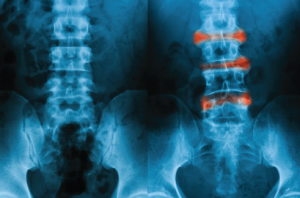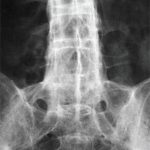“I haven’t been able to straighten either knee for, I don’t know how long.”
Now I understood why Josh was even shorter than what one would expect from the curvature of his back alone. With the knees partially flexed to accommodate the huge effusions, his hips would flex to compensate. Between the curvature of the back and the flexed knees and hips, Josh was 8–10 inches shorter than if he were fully erect. In truth, Josh resembled a modern-day Hunchback.
Above the waist, fluid within the elbow joints prevented full extension. One wrist was warm and boggy. His neck lacked any meaningful rotation or extension. When I asked Josh a question, he shifted his entire body to make eye contact; the neck was fused en bloc.
Rheumatologists have known for decades that patients who are HLA-B27+, may develop reactive arthritis after GI infections … [but] clarifying the triggers for AS has been elusive, in part due to the complex immunology of the gut.
Diagnosis

This L-S spine X-ray image, AP view, depicts a comparison of a normal (left) and ankylosing spondylitis (right) lumbar.
Suttha Burawonk/shutterstock.com
The diagnosis was evident on physical exam alone: ankylosing spondylitis. And I knew that even if medications could put out the fire of inflammation, reduce the swelling, improve the pain, there was no resetting the damage.
I stuck my head out the door and asked Joanne to set up for an aspiration and injection of each knee. On second thought, I decided to go through the details with her outside the room—and take a break. Josh was too crippled to lie flat on the exam table, and I’d need to position his knees carefully where he sat to drain them as completely as possible. I reminded her to bring in the entire aspiration tray: “We’ll need multiple 50 cc syringes, red-top tubes, and 2 cc of Depo-40 for each knee.”
Reflecting on Another Case
I had a few minutes. The next patient on my schedule had cancelled. I sat down in my office chair for a moment and drifted back to what I knew about ankylosing spondylitis (AS), and as usual, there were more unanswered questions than answers. For one, why is it that ankylosing spondylitis can be subtle in one patient and cruelly fulminant in another? Why are the sacroiliac joints involved (in most patients) early in the disease before inflammation ascends up the axial spine? Why do many AS patients have inflammatory eye disease with unilateral iritis? On colonoscopy, why do many AS patients have either macroscopic or microscopic patches of inflammatory bowel disease?



